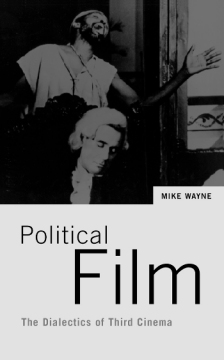
Additional Information
Book Details
Abstract
Third Cinema is a cinema committed to social and cultural emancipation. In this book, Mike Wayne argues that Third Cinema is absolutely central to key debates concerning contemporary film practices and cultures.
As a body of films, Third Cinema expands our horizons of the medium and its possibilities. Wayne develops Third Cinema theory by exploring its dialectical relations with First Cinema (dominant,commercial) and Second Cinema (arthouse, auteur). Discussing an eclectic range of films, from Evita to Dollar Mambo, The Big Lebowski to The Journey, Amistad to Camp de Thiaroye, Political Film explores the affinities and crucial political differences between First and Third Cinema.
Third Cinema’s relationship with Second Cinema is explored via the cinematic figure of the bandit (Bandit Queen, The General, Eskiya). The continuities and differences with European precursors such as Eisenstein, Vertov, Lukacs, Brecht and Walter Benjamin are also assessed. The book is a polemical call for a film criticism that is politically engaged with the life of the masses.
'One of those rare events in the publishing world which will enrich and possibly change our approach to film criticism'
Film Waves
Table of Contents
| Section Title | Page | Action | Price |
|---|---|---|---|
| Contents | v | ||
| Acknowledgements | ix | ||
| Introduction | 1 | ||
| 1 Third Cinema as Critical Practice: A Case Study of The Battle of Algiers | 5 | ||
| ONCE AGAIN, THE BATTLE OF ALGIERS | 8 | ||
| THE BATTLE OF ALGIERS: THE CRITICAL RECEPTION | 9 | ||
| THE BATTLE OF ALGIERS: FIRST, SECOND AND THIRD CINEMA | 14 | ||
| 2 Precursors | 25 | ||
| CRISIS AND REVOLT | 25 | ||
| MODERNISM, EISENSTEIN AND VERTOV | 27 | ||
| LUKÁCS | 33 | ||
| BRECHT AND BENJAMIN | 41 | ||
| 3 Dialectics of First and Third Cinema | 47 | ||
| RELATIONS OF PRODUCTION | 47 | ||
| COLLECTIVE PRODUCTION IN THE UK | 48 | ||
| BOORMAN AND THE EMERALD FOREST | 52 | ||
| JORGE SANJINÉS AND THE UKAMAU GROUP | 55 | ||
| GUERRILLA CINEMA | 56 | ||
| HISTORICITY | 59 | ||
| HISTORY, HEGEL AND MARX | 63 | ||
| A MARXIST DEFINITION OF TRAGEDY | 67 | ||
| POLITICISATION AND COMMITMENT | 68 | ||
| REVOLUTION AND THIRD CINEMA | 71 | ||
| CULTURAL SPECIFICITY AND POPULAR MEMORY | 75 | ||
| DISTRIBUTION AND EXHIBITION: CAPITAL AND THE STATE | 78 | ||
| 4 Dialectics of Second Cinema: The Bandit | 82 | ||
| HISTORICAL BANDITS AND CELLULOID BANDITS | 82 | ||
| THE BANDIT AND THE GANGSTER | 83 | ||
| THE BANDIT AND FIRST CINEMA | 85 | ||
| THE BANDIT AND SECOND CINEMA | 86 | ||
| BANDIT QUEEN | 93 | ||
| 5 Dialectics of Third Cinema | 108 | ||
| A PHILOSOPHY OF MEMORY | 109 | ||
| CULTURAL IMPERIALISM | 112 | ||
| POSTCOLONIAL THEORY: MEANS AND ENDS | 114 | ||
| CONTEXTUALISING ‘TOWARDS A THIRD CINEMA’ | 118 | ||
| ON THE ROLE OF THE INTELLECTUAL | 119 | ||
| THE NATIONAL QUESTION | 121 | ||
| FICTION AND DOCUMENTARY | 124 | ||
| THE DIALOGIC TEXT | 126 | ||
| ALLEGORY AND SATIRE | 129 | ||
| GENERIC TRANSFORMATIONS: THE MUSICAL | 136 | ||
| THE VIEWER’S DIALECTIC | 145 | ||
| CUBA AND THE ELEPHANT AND THE BICYCLE | 151 | ||
| Bibliography | 157 | ||
| Index | 161 | ||
| Akomfrah, John, 2 | 2 | ||
| Alea, Tomàs Gutiérrez | 4 |
